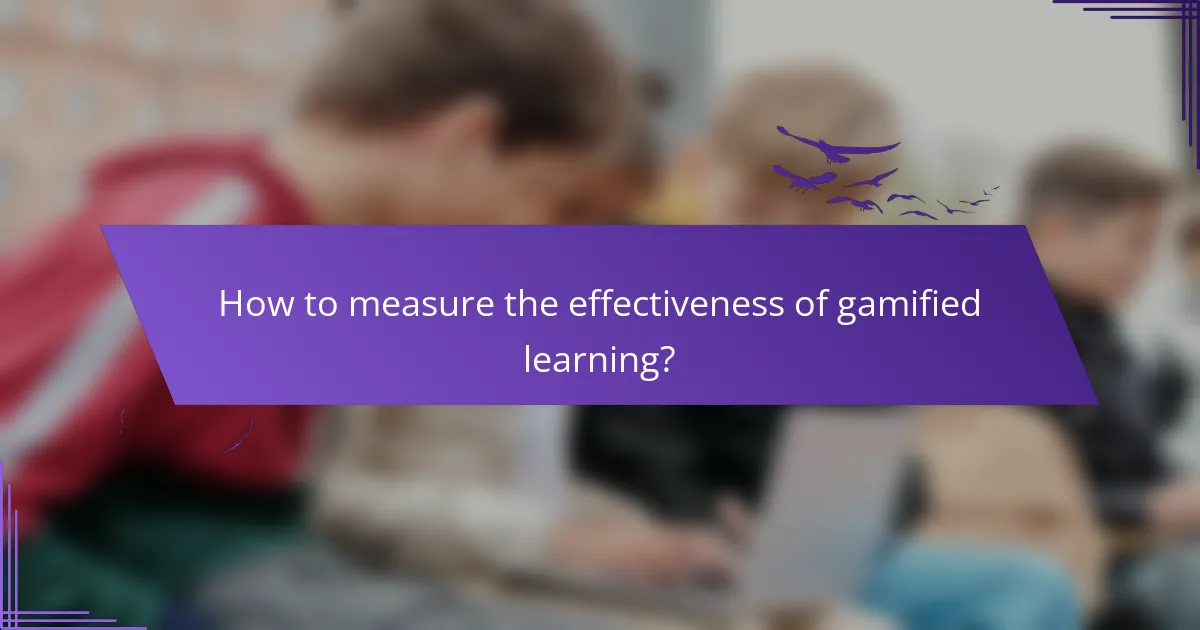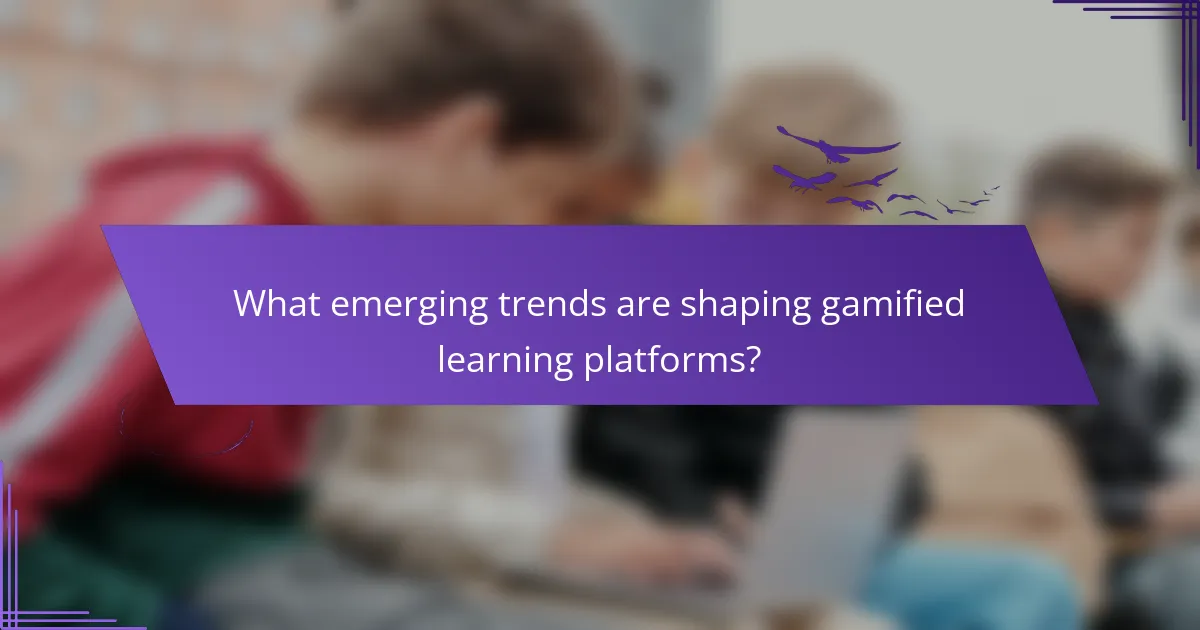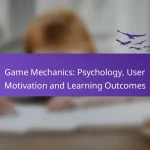Gamified learning platforms play a crucial role in enhancing engagement and retention in online education by incorporating interactive and game-like elements. Selecting the right technology involves evaluating user engagement features, integration capabilities, and scalability to meet educational goals effectively. A focus on user experience, including intuitive design and personalized learning paths, further enriches the learning environment, keeping learners motivated and engaged.

What are the best gamified learning platforms for online courses?
The best gamified learning platforms for online courses enhance engagement and retention through interactive and game-like elements. Popular options include Kahoot!, Quizlet, Edmodo, Classcraft, and TalentLMS, each offering unique features suited to different learning environments.
Kahoot!
Kahoot! is a game-based learning platform that allows educators to create quizzes and interactive games. Users can participate in real-time, making it ideal for classrooms and virtual learning environments.
Consider using Kahoot! for formative assessments or to introduce new topics. Its user-friendly interface and mobile compatibility make it accessible for students of all ages.
Quizlet
Quizlet offers a range of study tools, including flashcards, quizzes, and games. It allows users to create custom study sets or choose from millions of existing ones, making it versatile for various subjects.
Utilize Quizlet’s gamified learning features, such as Quizlet Live, to encourage collaboration among students. This platform is particularly effective for memorization and vocabulary building.
Edmodo
Edmodo is a social learning platform that combines classroom management with gamified elements. It allows teachers to create assignments, quizzes, and polls while facilitating communication between students and educators.
Leverage Edmodo’s features to foster a collaborative learning environment. Its integration with various educational tools can enhance the overall learning experience.
Classcraft
Classcraft transforms the classroom into a role-playing game where students earn points for positive behavior and academic achievements. This platform encourages teamwork and engagement through its unique storytelling approach.
Consider Classcraft if you want to motivate students through gamification. Its focus on social-emotional learning can help build a positive classroom culture.
TalentLMS
TalentLMS is a learning management system that incorporates gamification to enhance user experience. It offers features like badges, leaderboards, and rewards to motivate learners and track progress.
Use TalentLMS for corporate training or professional development. Its scalability and customization options make it suitable for organizations of various sizes, ensuring a tailored learning experience.

How to select the right technology for gamified learning?
Selecting the right technology for gamified learning involves assessing user engagement features, integration capabilities, and scalability options. Prioritizing these elements ensures that the platform meets educational goals while providing an enjoyable experience for users.
Assess user engagement features
User engagement features are critical for maintaining interest and motivation in a gamified learning environment. Look for elements such as interactive quizzes, leaderboards, badges, and progress tracking. These features can significantly enhance the learning experience by making it more immersive and rewarding.
Consider platforms that offer customizable engagement tools, allowing you to tailor experiences to different learner demographics. For example, younger audiences may respond better to colorful graphics and animated feedback, while adult learners might prefer more sophisticated analytics and rewards.
Evaluate integration capabilities
Integration capabilities are essential for ensuring that your gamified learning platform works seamlessly with existing systems. Check if the technology can easily connect with Learning Management Systems (LMS), Customer Relationship Management (CRM) tools, and other educational resources. This interoperability can streamline data sharing and enhance the overall user experience.
When evaluating integration options, prioritize platforms that support standard APIs and data formats. This flexibility can save time and resources during implementation, making it easier to adapt the technology to your specific needs.
Consider scalability options
Scalability options determine how well the gamified learning platform can grow with your organization. Choose a solution that can handle an increasing number of users and content without compromising performance. Look for cloud-based platforms that offer flexible pricing models based on user volume, which can be more cost-effective in the long run.
Additionally, assess the platform’s ability to expand its features and functionalities. A scalable solution should allow for the addition of new courses, user roles, and engagement tools as your educational needs evolve. This adaptability is crucial for long-term success in a rapidly changing learning landscape.

What user experience factors enhance gamified learning?
User experience factors that enhance gamified learning include intuitive interface design, responsive mobile access, and personalized learning paths. These elements work together to create an engaging and effective educational environment that keeps learners motivated and focused.
Intuitive interface design
An intuitive interface design is crucial for gamified learning platforms as it allows users to navigate easily without confusion. Key considerations include clear navigation menus, recognizable icons, and a visually appealing layout that draws users in. A well-designed interface can significantly reduce the learning curve and increase user satisfaction.
To achieve an intuitive design, prioritize user feedback during development. Conduct usability testing with actual learners to identify pain points and areas for improvement. Aim for a clean, uncluttered interface that highlights essential features and minimizes distractions.
Responsive mobile access
Responsive mobile access ensures that learners can engage with gamified content on various devices, including smartphones and tablets. This flexibility is essential as it allows users to learn anytime and anywhere, accommodating different lifestyles and schedules. A mobile-friendly design should adapt seamlessly to different screen sizes and orientations.
When developing a mobile version, focus on touch-friendly interactions and optimize loading times. Consider implementing offline capabilities to allow users to continue learning without a constant internet connection. Regularly test the mobile experience to ensure it meets user expectations and maintains functionality across devices.
Personalized learning paths
Personalized learning paths cater to individual learner needs, preferences, and progress, making the experience more relevant and engaging. By assessing user performance and interests, platforms can tailor content and challenges to keep learners motivated. This customization can lead to better retention and improved outcomes.
To implement personalized learning paths, utilize data analytics to track user interactions and achievements. Offer options for learners to choose their topics or difficulty levels, and provide adaptive feedback that guides them through their learning journey. Regularly review and adjust these paths based on user feedback and performance metrics to enhance effectiveness.

How does scalability impact gamified learning platforms?
Scalability is crucial for gamified learning platforms as it determines their ability to accommodate a growing number of users and content without sacrificing performance. A well-scaled platform can enhance user experience, maintain engagement, and support educational goals effectively.
Support for large user bases
To support large user bases, gamified learning platforms must be designed with robust architecture that can handle simultaneous access. This often involves using cloud services that allow for dynamic resource allocation, enabling the platform to expand or contract based on user demand.
Consider implementing a microservices architecture, which allows different components of the platform to scale independently. This approach can help manage user load more efficiently, ensuring that features like leaderboards and interactive content remain responsive even during peak times.
Performance under high load
Performance during high load is essential for maintaining user engagement in gamified learning environments. Platforms should be tested for load capacity to identify potential bottlenecks and optimize performance before they become an issue.
Utilizing content delivery networks (CDNs) can significantly improve load times by distributing content closer to users. Additionally, employing caching strategies can reduce server strain, allowing for faster access to frequently used resources.

What are the prerequisites for implementing gamified learning?
Implementing gamified learning requires a solid foundation in technology infrastructure and adequate staff training. These prerequisites ensure that the platform operates effectively and that educators can leverage its features to enhance learning experiences.
Technology infrastructure
A robust technology infrastructure is essential for supporting gamified learning platforms. This includes reliable internet connectivity, sufficient server capacity, and compatible devices for both educators and learners. Consider cloud-based solutions for scalability and flexibility, allowing for easy updates and maintenance.
When selecting technology, prioritize platforms that offer user-friendly interfaces and integration capabilities with existing systems. Look for tools that support various multimedia formats, as diverse content can enhance engagement. Ensure the infrastructure can handle peak usage times without performance degradation.
Staff training requirements
Effective staff training is crucial for the successful implementation of gamified learning. Educators should be familiar with the platform’s features and how to create engaging content that aligns with learning objectives. Training sessions can include hands-on workshops and online tutorials to accommodate different learning styles.
Encourage ongoing professional development to keep staff updated on new features and best practices. Consider peer mentoring programs where experienced users can support less experienced colleagues. This collaborative approach fosters a culture of continuous improvement and innovation in teaching methods.

How to measure the effectiveness of gamified learning?
Measuring the effectiveness of gamified learning involves evaluating user engagement, knowledge retention, and overall satisfaction. Key methods include gathering user feedback, analyzing performance metrics, and observing behavioral changes over time.
User feedback and surveys
User feedback is crucial for assessing the impact of gamified learning experiences. Surveys can be designed to capture participants’ perceptions of the platform, including enjoyment, usability, and perceived learning outcomes. Aim for a mix of quantitative questions (e.g., rating scales) and qualitative open-ended questions to gather comprehensive insights.
Consider conducting surveys at multiple points, such as after specific modules or at the end of a course. This approach allows you to track changes in user sentiment and identify areas for improvement. Additionally, incentivizing feedback through rewards can increase participation rates.
Analytics and performance metrics
Analytics play a vital role in measuring the effectiveness of gamified learning. Key performance metrics include completion rates, time spent on tasks, and scores achieved in assessments. Tools like Learning Management Systems (LMS) can provide detailed reports that help identify trends and patterns in user engagement.
Benchmarking these metrics against industry standards can provide context. For instance, a completion rate above 70% is often considered successful. Regularly review these analytics to make data-driven decisions about content adjustments and platform enhancements, ensuring that the learning experience remains effective and engaging.

What emerging trends are shaping gamified learning platforms?
Emerging trends in gamified learning platforms focus on personalized experiences, integration of artificial intelligence, and the use of immersive technologies like virtual and augmented reality. These trends enhance engagement and effectiveness in educational settings, catering to diverse learning styles and preferences.
Personalization and Adaptive Learning
Personalization in gamified learning platforms tailors content and challenges to individual user needs, enhancing motivation and retention. Adaptive learning technologies assess user performance in real-time, adjusting difficulty levels and content types accordingly.
For example, platforms may use algorithms to recommend specific games or modules based on a learner’s past performance, ensuring a customized educational journey. This approach can significantly improve learning outcomes by addressing gaps in knowledge and catering to varying skill levels.
Artificial Intelligence Integration
Artificial intelligence (AI) is increasingly being integrated into gamified learning platforms to provide intelligent feedback and support. AI can analyze user interactions to offer personalized tips and resources, making the learning experience more efficient.
Additionally, AI-driven chatbots can assist learners by answering questions and guiding them through challenges, enhancing user engagement. This technology not only streamlines the learning process but also allows for continuous improvement based on user data.
Immersive Technologies: VR and AR
Virtual reality (VR) and augmented reality (AR) are revolutionizing gamified learning by creating immersive environments that enhance engagement. These technologies allow learners to interact with content in a 3D space, making complex concepts easier to understand.
For instance, a VR simulation can place students in a historical event, providing a deeper understanding of the subject matter. Similarly, AR can overlay digital information onto the real world, facilitating interactive learning experiences that are both fun and educational.
Social Learning and Collaboration
Social learning features in gamified platforms encourage collaboration and peer interaction, which can enhance motivation and knowledge sharing. Elements such as leaderboards, team challenges, and community forums foster a sense of belonging and competition among learners.
By incorporating social elements, platforms can leverage the power of community to drive engagement. For example, learners may work together to solve challenges, share achievements, and provide feedback, creating a more dynamic learning environment.
Data Analytics for Continuous Improvement
Data analytics play a crucial role in the evolution of gamified learning platforms by providing insights into user behavior and learning outcomes. Platforms can track engagement metrics, completion rates, and user feedback to refine content and improve the overall experience.
By analyzing this data, educators and platform developers can identify trends and areas for improvement, ensuring that the learning experience remains relevant and effective. Regular updates based on analytics can help maintain user interest and enhance educational effectiveness.


